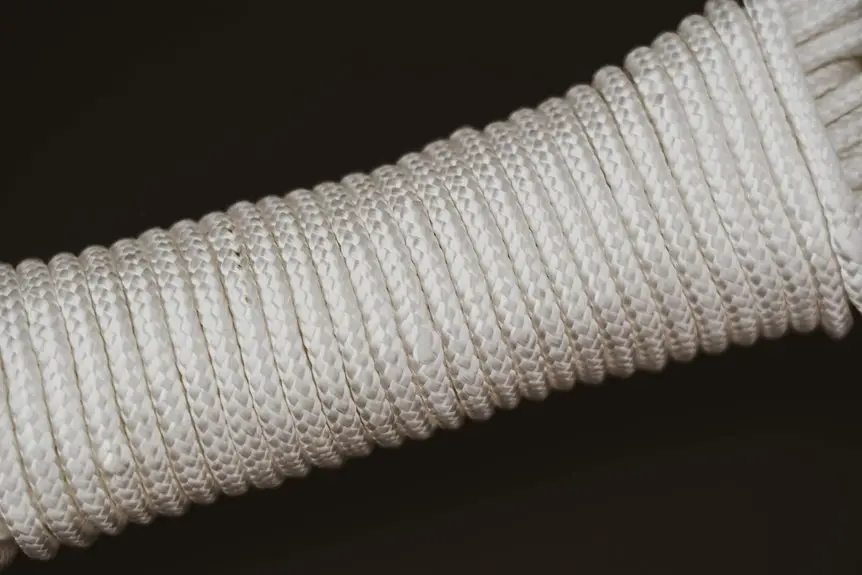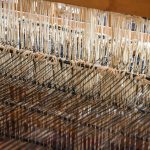When choosing between Dyneema and Kevlar, you want the strongest, lightest option—Dyneema fits that bill with about 15-20% more tensile strength and 40% less weight. It also resists moisture, UV, and chemicals better than Kevlar. Kevlar still shines in heat resistance and durability, but if strength and weight matter most, Dyneema leads. If you keep exploring, you’ll find how these fibers compare in use, cost, and care.
Table of Contents
Key Takeaways
- Dyneema has about 15-20% higher tensile strength than Kevlar, making it the stronger synthetic fiber overall.
- Dyneema is 40% lighter than Kevlar, offering a superior strength-to-weight ratio.
- Kevlar features rigid chemical bonds providing toughness, but Dyneema’s molecular alignment yields greater strength and flexibility.
- Dyneema resists moisture, UV rays, and chemicals better than Kevlar, maintaining strength in harsh conditions.
- Kevlar is more heat-resistant and cost-effective, but Dyneema’s advanced production delivers stronger, lighter fiber for demanding uses.
Chemical Composition and Molecular Structure
Although both Dyneema and Kevlar are high-performance fibers, their chemical compositions and molecular structures differ markedly.
When you look at Dyneema, you’ll find it’s made from ultra-high-molecular-weight polyethylene (UHMWPE). This means long chains of polyethylene molecules align tightly, giving it exceptional strength and resistance to abrasion.
Kevlar, on the other hand, is an aramid fiber composed of aromatic polyamides. Its molecular chains form rigid, rod-like structures held together by strong hydrogen bonds, creating a highly ordered and stable framework.
You’ll notice that Dyneema’s structure emphasizes molecular alignment and low density, while Kevlar relies on rigid chemical bonds for toughness.
Understanding these differences helps you appreciate how each fiber achieves its unique combination of performance characteristics.
Tensile Strength and Weight Comparison
When comparing Dyneema and Kevlar, you’ll find that Dyneema offers higher tensile strength while being considerably lighter. This makes Dyneema a top choice when strength-to-weight ratio matters most.
Here’s how they stack up:
- Tensile Strength: Dyneema exceeds Kevlar by about 15-20%, meaning it can withstand more force before breaking.
- Weight: Dyneema is roughly 40% lighter, so it won’t weigh you down in applications like body armor or climbing gear.
- Strength-to-Weight Ratio: Dyneema’s superior ratio lets you carry less weight without compromising protection or durability.
You’ll appreciate Dyneema’s combination of strength and lightness, especially if you need high performance without bulk.
Kevlar remains strong, but Dyneema pushes the limits further in tensile strength and reduced weight.
Resistance to Environmental Factors
Beyond tensile strength and weight, you’ll want to contemplate how Dyneema and Kevlar hold up against environmental challenges.
Dyneema boasts exceptional resistance to moisture, UV rays, and chemicals, making it highly durable in harsh outdoor conditions. It won’t absorb water or degrade easily, so it maintains strength even when wet.
Kevlar, however, is more sensitive to UV exposure and can weaken over time if left in direct sunlight without protective coatings. It’s also prone to absorb moisture, which might reduce its performance in damp environments.
If you need a fiber that stays tough under prolonged exposure to sun, water, and chemicals, Dyneema offers superior resilience. Kevlar requires more care to preserve its integrity when facing environmental stressors. This difference can be significant depending on your specific use.
Common Applications and Industry Use
Industries rely on both Dyneema and Kevlar for their unique strengths and properties in various applications.
Both Dyneema and Kevlar offer distinct advantages tailored to diverse industrial needs and applications.
When you choose Dyneema, you tap into its ultra-lightweight nature, making it perfect for personal protective gear and high-performance sports equipment.
Kevlar, on the other hand, excels where heat resistance and durability are essential.
Here’s where you’ll commonly see them:
- Dyneema: Used in cut-resistant gloves, ballistic vests, and climbing ropes due to its high strength-to-weight ratio.
- Kevlar: Found in bulletproof vests, motorcycle apparel, and aerospace components for its toughness and heat resistance.
- Both fibers: Applied in marine ropes and cables, balancing strength and flexibility for harsh environments.
Picking the right fiber depends on your specific needs in strength, weight, and endurance.
Durability and Maintenance Requirements
Although both Dyneema and Kevlar offer impressive strength, their durability and maintenance needs differ considerably.
When you use Dyneema, you’ll appreciate its excellent resistance to moisture, UV rays, and chemicals, which means it won’t degrade easily outdoors. It’s also less prone to abrasion, so it lasts longer with minimal care.
Kevlar, on the other hand, offers great heat resistance but can degrade faster when exposed to UV light and moisture, so you’ll need to handle it more carefully and avoid prolonged sun exposure.
For maintenance, Dyneema usually requires just routine cleaning with mild soap and water, while Kevlar might demand more frequent inspections for damage and specialized care to maintain its protective qualities.
Understanding these differences helps you choose the right fabric for your needs.
Cost and Availability Analysis
When you’re comparing Dyneema and Kevlar, cost plays a big role in your choice.
You’ll find differences in price and how easy each fabric is to get your hands on.
Let’s look at market trends and supply chain factors that impact their availability.
Price Comparison Overview
Since you’re considering Dyneema fabric and Kevlar for your project, understanding their cost and availability is essential.
Here’s a quick price comparison overview to guide your decision:
- Dyneema tends to be pricier upfront due to its advanced manufacturing process and exceptional strength-to-weight ratio.
- Kevlar usually comes at a lower initial cost, making it more accessible for budget-conscious projects.
- Availability varies—Dyneema’s specialized production can limit immediate supply, while Kevlar benefits from widespread distribution channels.
Keep in mind, your choice depends not just on price but also on how each fabric’s properties align with your project needs.
Balancing cost with performance will help you make the smartest investment.
Market Accessibility Trends
As you explore market accessibility trends for Dyneema and Kevlar, you’ll notice that cost fluctuations and supply chain dynamics play significant roles.
Dyneema tends to be pricier upfront due to its advanced manufacturing process, yet its lightweight nature often reduces overall project expenses. Kevlar, being more established, usually offers broader availability and competitive pricing, making it easier for you to source in bulk.
However, both fibers face pricing variability influenced by raw material costs and global demand shifts.
When it comes to availability, Kevlar’s longer market presence means you’ll find it in more industries and suppliers. Dyneema’s growing popularity is improving access, but it may still require you to navigate niche suppliers depending on your location.
Understanding these trends helps you plan purchases strategically without unexpected delays or costs.
Supply Chain Factors
Although both Dyneema and Kevlar offer unique advantages, their supply chains present distinct challenges that directly impact cost and availability. When you decide between them, consider these factors:
1. Raw Material Sourcing: Dyneema relies on ultra-high molecular weight polyethylene, which is less common and can cause price fluctuations.
Kevlar uses aramid fibers, more established in production, often making it easier to source.
2. Manufacturing Complexity: Dyneema’s production requires specialized techniques, increasing costs and limiting rapid scalability.
Kevlar’s established processes allow for quicker, more cost-effective manufacturing.
3. Distribution Networks: Kevlar benefits from broader industrial adoption, ensuring better availability globally.
Dyneema, while growing, may face regional supply constraints.
Understanding these supply chain nuances helps you weigh cost against availability when choosing the right synthetic fiber for your needs.
Frequently Asked Questions
Can Dyneema or Kevlar Be Recycled Effectively?
You might think recycling tough fibers is easy, but Dyneema and Kevlar challenge that. While Dyneema recycles more efficiently due to its simpler structure, Kevlar’s complex weave makes recycling trickier for you to handle effectively.
How Do Dyneema and Kevlar Perform Under Extreme Heat?
You’ll find Kevlar performs better under extreme heat, resisting up to about 450°C, while Dyneema melts around 150°C. So, if heat resistance matters, Kevlar’s your safer choice for high-temperature environments.
Are There Any Health Risks When Handling Dyneema or Kevlar Fibers?
You should avoid inhaling dust or fibers from Dyneema or Kevlar since they can irritate your lungs. Wearing gloves and masks helps protect you while handling these materials to minimize any health risks.
What Are the Environmental Impacts of Producing Dyneema Versus Kevlar?
Think of environmental impact like a footprint in the sand: Dyneema’s production demands less energy and emits fewer greenhouse gases than Kevlar, so when you choose Dyneema, you’re leaving a lighter mark on the planet.
Can Dyneema or Kevlar Be Dyed or Colored Easily?
You’ll find Dyneema’s ultra-high molecular weight polyethylene resists dyes, making coloring tough. Kevlar, however, accepts dyes better but still requires special processes. So, you can color Kevlar easier than Dyneema overall.
- Recycling Nonwoven Fabrics: Is It Possible? - July 11, 2025
- Recycling Nonwoven Fabrics: Is It Possible? - July 11, 2025
- Recycling Nonwoven Fabrics: Is It Possible? - July 11, 2025







